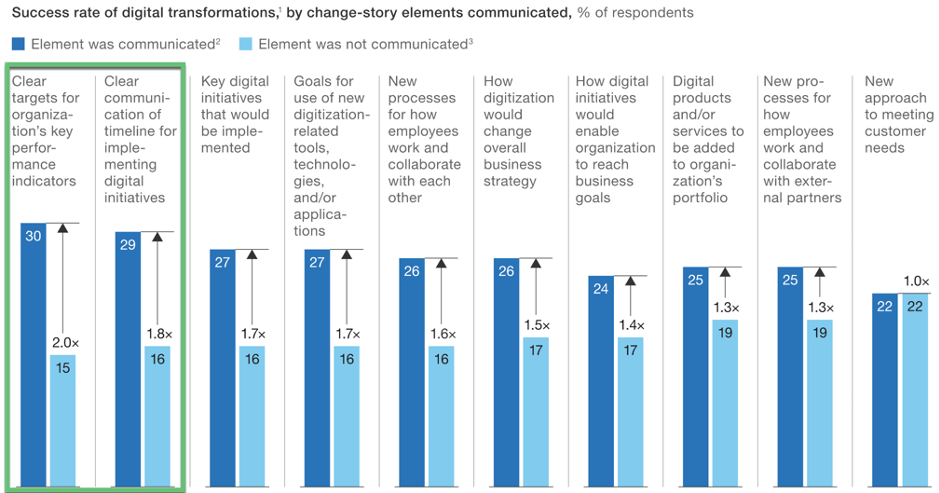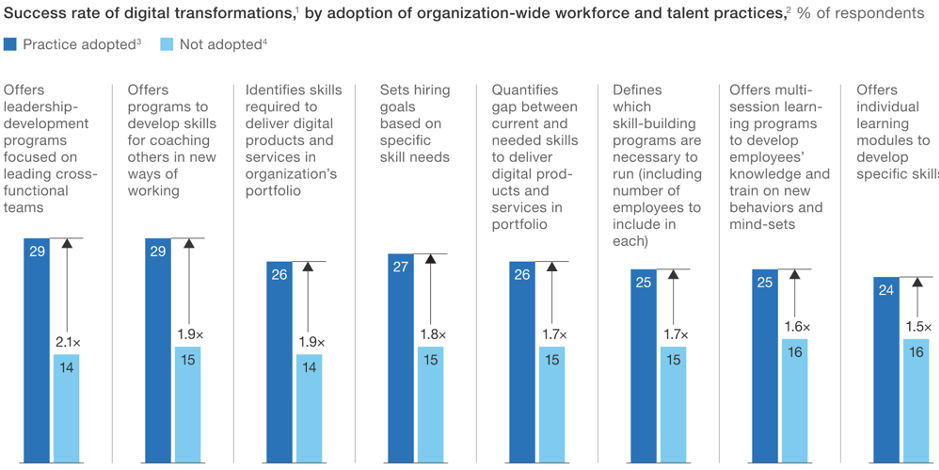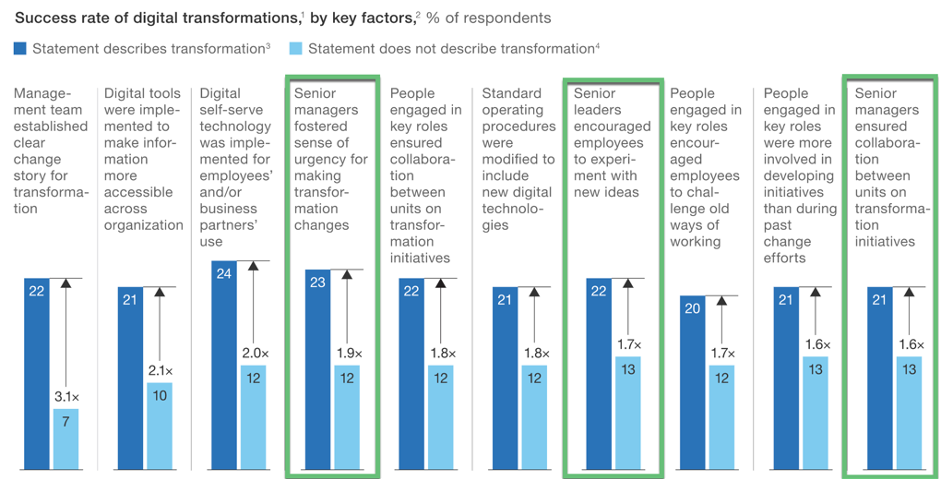Digital Transformation: How To Future-Proof Your Business, Right Now
We all live in the digital age, so no matter the size, industry, or age of your organization, you need to adopt the right mindset, processes, and tools to maximize operational excellence and thrive in our highly-competitive, always-changing world.
In this article, we’re going to look at how to future-proof your business through digital transformation. We’ll take a look at what digital transformation is (and isn’t), why it matters, and how you can implement it in your business.
Let’s begin.

Manage all your social media accounts in one place.
Craft, schedule, & auto-post content to all your social channels, then track analytics and manage interactions from a single, easy-to-use dashboard.
What Digital Transformation Is — and Is Not
Digital transformation not only concerns how an organization embraces technology but also how it deploys people and processes. It involves a rethinking from top to bottom, that strives to deliver better products and services to satisfy customer expectations.
According to Salesforce:
“Digital transformation is the process of using digital technologies to create new — or modify existing — business processes, culture, and customer experiences to meet changing business and market requirements.”
However, the term digital transformation sometimes gets confused with the similar-sounding terms digitization and digitalization, when all three have a different meaning:
- Digitization is the process of converting information from analog to digital.
For example, before computers existed, accountants entered handwritten records in paper ledgers and journals. But even after converting to computerized accounting systems, businesses worked in the same way, so there was no change in the business process.
- Digitalization is the process of using digital data to simplify how you work.
For example, accountants can use digitized data to quickly retrieve information on a customer’s credit history rather than having to sift through dusty archives in the basement. But notice how there’s still no change in business process, just a quicker, more efficient way to carry out the same tasks as before.
- Digital transformation changes the way business gets done.
For example, accountants might examine the way they work and ask how they can improve existing processes to serve their customers better. (In this scenario, customers refer to both their internal customers, such as the CEO and Sales Director, as well as their external customers.) As a result, they might decide to introduce a new process to proactively inform customers of outstanding invoices rather than jeopardizing cashflow for the business.
The successful digital transformation of the U.S. Citizenship and Immigration Service (USCIS) highlights how each of these key terms played out. When Mark Schwartz was appointed CIO in 2010, he divided the transformation program into three parts:
- Digitize all of the paper forms and paper-based processes that the agency handled. (Apparently, if you stacked the total amount of paper that the agency received each day on top of each other, it would have been almost double that of the Statue of Liberty.)
- Transform the department’s approach into a more customer-centric model.
- Centralize digital applications.

Interestingly, Schwartz said the key to the successful transformation was down to a model called FADS — Flexible Agile Development Services — which allowed departments to expand and collaborate with others.
Why Digital Transformation Matters
Most businesses have to embrace digital transformation so they can survive, especially when agile startups disrupt the market.
For instance, when Uber appeared on the scene, taxi firms had to transform their business model to meet customers’ new expectations. That meant embracing new technology, so customers could contact them via mobile apps as well as booking in advance over the phone.

Another example is the banking sector. Remember how traditional Main Street banks operated? If you wanted to open an account or apply for a loan, it often meant sitting in a stuffy office, answering tedious questions and filling in reams of paperwork.
Now, thanks to new online banks like Starling, customers can open an account on a mobile app and get loans approved quickly, even over the weekend.

While traditional banks dithered over approving special UK government business loans, newcomers like Starling welcomed new customers and processed loan applications within days rather than weeks.
But it’s not only customers who drive digital transformation projects. Employees can also have a say on matters.
A few years ago, Blackberry was the mobile phone of choice for IT departments. It was safe and secure, and they knew how to manage the backend servers as well as service employee questions about the handsets.
Then Apple launched the iPhone. Although it wasn’t aimed at the corporate sector, people loved it, and employees wanted it as their business mobile phone.

At first, IT departments resisted, but slowly, one by one, more companies adapted to change and allowed the iPhone onboard. As a result, Blackberry slipped as the corporate mobile phone of choice, as it failed to transform and meet customer expectations.
However, this switch also signified a transformation in the mindset of IT departments. Previously, they dictated which devices employees could use. Now, they take account of what technology their customers — i.e. the employees — want and where possible, facilitate their selection.
How to Implement Digital Transformation in Your Organization
Digital transformation will look different for every company, but some fundamental principles can be applied to each organization:
- Acknowledging change is required
- Improving customer and employee experience
- Empowering people to work differently
- Embracing innovation through new methods and tools
- Leading from the top
- Modernizing company culture
Let’s take a look at each one in turn.
1. Acknowledging change is required
You can’t perform any digital transformation without acknowledging that change is required.
Even though it might be tough, change is inevitable. But that doesn’t mean you have to force the changes through. It’s much easier to suggest and make changes with your employees behind you rather than fighting against their resistance.
One of the best ways to get everyone on board is to communicate clearly. When you describe your strategy clearly, employees acknowledge and understand where your organization is heading, why it’s changing, and why the changes are important.
Organizations with clear targets and a change timeline are most successful:

It’s also worth changing your communication channels from traditional one-way systems, like company-wide emails, to more interactive platforms, such as Slack, where everyone across the organization can discuss topics.
2. Improving customer and employee experience
Implementing digital transformation needs to be customer-driven.
Successful brands such as Apple, Spotify, Nike, and Starbucks keep their brand relevant by providing the best customer experience. They don’t ask customers to fit in with their processes. Instead, they shape their products and services to meet customer expectations to ensure they remain connected.
According to a study by IBM, 68% of CXOs said they expected their organization to emphasize CX over products in the future.
Also, remember to improve your employee experience, too. Are you providing the best tech gear so they can accomplish their everyday tasks quickly and efficiently? When employees have a positive experience in their job, you’ll find they’re more productive.
3. Empowering people to work differently
Developing people’s talent and skills throughout your organization is one of the most critical factors in a successful transformation.
According to Daniel Newman:
“Companies that invest in their people, commit to their development, and respect their ideas build a loyalty that makes change management much easier to realize within the walls of the company.”
Using the latest technology is only half of the equation. You’ll need to empower your employees to work in new ways so that you can complete the transformation.
Research from McKinsey showed that companies with cross-functional or enterprise-wide workforce planning and talent development programs are more likely to have successful digital transformations:

For example, during your digital transformation, you could:
- Encourage employees to challenge old ways of working.
- Give employees a say on where to use digitization.
- Train employees to coach others in a new way of working.
4. Embracing innovation through new methods and tools
All transformations require an element of innovation, whether that’s the development of a new product, the creation of a new service, or the implementation of a new process.
Successful digital transformations often assign specific roles of integrators and technology-innovation managers. The idea of these roles is to bridge the gap between the traditional and digital parts of the business. As these employees understand the technical aspects and business potential of digital technologies, they’re able to guide the company in the right direction.
5. Having the right digital-savvy leadership
For digital transformation to succeed, it’s crucial that the leadership team, including CEOs, drive the program. It’s also vital that senior leaders are familiar with the latest digital technologies, so they can assess what to use or discard.
McKinsey’s research showed that companies who employed a Chief Digital Officer (CDO) were 1.6 more times likely to succeed with their digital transformation.
Further key success factors highlight the need for strong senior leadership:
- Senior managers fostered a sense of urgency for making transformation changes.
- Senior leaders encouraged employees to experiment with new ideas.
- Senior manager ensured collaboration between units on transformation initiatives. (As we saw earlier with the USCIS success story.)

6. Modernizing company culture
The underlying theme of all these steps is to cultivate the right culture. It’s not merely a case of changing a few processes and updating your tech stack.
Digital transformation involves with a change in company culture.
When you acknowledge change is required, improve customer and employee experiences, empower staff to work in new ways, embrace innovation, and lead from the front, you’ll create a culture that’s ready for a transformation.
Digital Transformation in a Nutshell
Here’s a quick recap on what we’ve covered today.
Digital transformation not only concerns how an organization embraces the latest technology but also requires a change and investment in people, structure, processes, and culture. It’s a company-wide shift in mindset.
Organizations run successful digital transformations to improve their customer experience and future-proof their business.
The six key elements under-pinning a successful digital transformation are:
- Acknowledging change is required
- Improving customer and employee experience
- Empowering people to work differently
- Embracing innovation through new methods and tools
- Leading from the top
- Modernizing company culture



